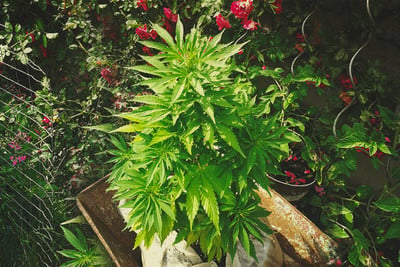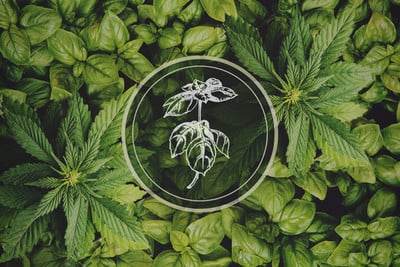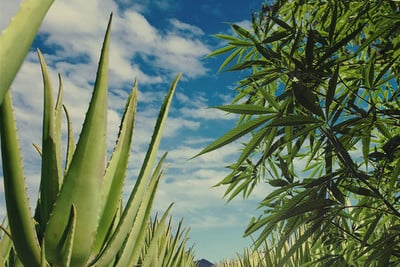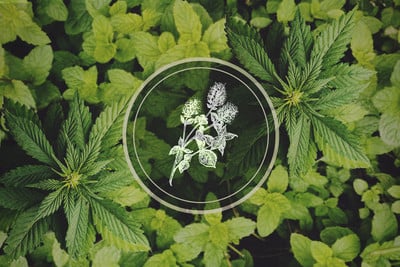.

How Stinging Nettles Benefit Cannabis Plants
What comes to mind when you stumble across a patch of stinging nettles? They probably set off some alarm bells, following past experiences. However, when used in the right way, nettles offer cannabis growers protection and fertility. We're going to introduce you—properly—to nettles, and show you how to use them as a companion plant and fertiliser.
What's your take on stinging nettles? We're pretty sure we have a good idea about your opinion of this oft-misunderstood plant. However, we're about to change the way you view stinging nettles forever—from a botanical annoyance, to an effective companion plant and source of important plant nutrients.
Contents:
What Are Stinging Nettles?
If you grow cannabis in a climate that receives decent rainfall, you’ll know all about stinging nettle[2]. This herbaceous perennial has the ability to interrupt your gentle stroll through the garden with a burning sensation within a matter of seconds. While native to Europe, parts of Asia, and western North Africa, nettle weed has made its way across the world, from North America to New Zealand. This resilient plant has a tendency to follow in the footsteps of human activity, and often pops up in disturbed areas such as roadside ditches and building sites.
The Latin binomial Urtica dioica describes the key characteristics of this fear-stoking plant. “Urtica” derives from the Latin word meaning “sting”, whereas “dioica” stems from Greek and translates to “of two houses”. The latter term denotes the dioecious nature of stinging nettle. Much like cannabis, plants are either male or female, as opposed to monoecious plants that possess both male and female reproductive organs. Female nettle plants feature flowers that hang downwards, whereas male nettle plants display flowers that point up at the ends.
Most gardeners know nettles for their sting. Similar to cannabis, nettles also possess trichomes that they use to defend against predators[3]. Upon contact, these spiky hairs pierce the skin and release a cocktail of formic acid, acetylcholine, serotonin, and histamine. This barrage of chemicals quickly causes swelling, bumps, and a stinging sensation. But nettles aren’t all bad[4]. Historically, the Romans are known to have consumed nettles[1], and they’re packed with terpenoids[5], carotenoids, fatty acids, and minerals.

Now that you’re more familiar with nettle weed, find out how you can use it to your advantage when growing cannabis.
The Benefits of Stinging Nettle for Cannabis
If you regularly grow cannabis outdoors, you’ve probably spent a fair amount of time attempting to eliminate every nettle in sight. Don’t worry, we completely understand! Nobody wants to spend every gardening session dodging sharp trichomes. However, nettles have their place in a cannabis garden. For one, they serve an important ecological role[6] as a food source for butterflies. Nettles also serve as a home for aphids[7], meaning they can tempt these hungry critters away from your cannabis plants. You’ll also find ladybugs patrolling nettle plants, meaning those aphids won’t pose an issue for long.
We highly recommend giving nettles a chance. This doesn’t mean that you have to grow all the nettles in a given place. However, leverage nettle intelligently, and you’ll see the health of your garden and the status of your plants take a turn for the better. What follows is an overview of the benefits of stinging nettle for your cannabis garden.
📈 Increased Terpene Production
Some veteran cultivators suggest that growing nettles in close proximity to cannabis plants results in higher levels of terpenes—the aromatic molecules that underpin the flavour and aroma of each strain. This theory comes from a claim made by fruit and vegetable gardeners that pollen from nearby nettles makes their harvests taste better—and the same could apply to weed. We need to wait for high-quality studies on this topic to confirm its validity, but we think it’s worth a shot!
🤐 Camouflage
Growing cannabis outdoors comes with a set of challenges, including keeping your plants hidden from snooping neighbours and would-be thieves. While there are many ways to keep your plants camouflaged, nettles are among the most effective (if you live in the right climate). These weeds are a common site in gardens across Europe, and they rarely attract attention. Importantly, they reach over a metre in height during the mid and late season, making them the perfect height to conceal stealthy autoflowers. You can recruit nettles to hide your weed plants by creating a perimeter around them, with enough room in the centre to allow adequate light penetration. The uninviting sting of the nettle barrier acts as an added bonus to turn off curious visitors.
🐛 Pest Control
Stinging nettle helps to deter pests in a couple of ways. The first, more passive method involves nettle working as a sacrificial or trap plant. This humble weed can help to divert pest traffic from b-lining towards your prized crops. Aphids have a penchant for munching cannabis, and they can inflict substantial damage if left to their own devices. However, these sap-sucking insects[8] also have a liking for nettle. Allowing these plants to occupy certain parts of your garden means offering pests a larger and more diverse vegetative banquet, reducing the likelihood of them solely targeting your weed specimens. Second, nettle makes for an effective natural insecticide[9] and fungicide for common pests and diseases, including mites, powdery mildew, and aphids.
🍃 Natural Fertiliser
Nettles contain a host of key plant nutrients—they are plants, after all. All of those nutrients are locked up inside their tissues when they’re alive and kicking. However, it only takes a few simple steps to convert living nettles into a nutrient-rich fertiliser that can benefit the health and yield of your cannabis plants. Nettle weed contains high levels of nitrogen, iron, and potassium[10]. Growers can administer these critical elements as a fast-acting foliar spray to maintain adequate nutrient levels and counteract deficiencies when they occur.

How to Use Stinging Nettles in Your Cannabis Garden
Have we changed your view of nettles? Sure, you’ll still go to great lengths to avoid getting stung, but now you realise that you have an important, free, and effective resource growing in your own garden. To further your appreciation for this stinging weed, we’ll show you two ways to harness nettles to the benefit of your cannabis crop.
1. Companion Planting
Companion planting, as the name suggests, involves growing beneficial plant species in close proximity to other crops to reap certain rewards. Stinging nettle flowers produce nectar that beneficial insects find irresistible; this weed will bring pollinators to your garden to keep other plants thriving. On top of this, nettle weed will draw aphids away from your cannabis, and ladybugs will swiftly arrive at the scene to neutralise this annoying pest.
Because nettles grow so densely, you can also use them as windbreaks and shading. If your region experiences frequent heat waves in the summer, position a wall of nettles in a manner to filter the afternoon sun. Likewise, you can plant nettles as a barrier against strong winds that gust through during the spring and autumn.
Before you get carried away, know that nettles are called weeds for a reason. These plants spread underground via their rhizomes, and can quickly take over a cultivation area[11]. If you don’t have the time to stay on top of this proliferative plant, consider growing them in pots to keep them contained.
2. Nettle Fertiliser Tea
Of the various uses of stinging nettle, fertiliser tea steals first place. Instead of viewing a patch of nettles as a problem, see them as free fertiliser that can reduce your dependency on bottled products. Before slashing them down and throwing them onto the compost pile, check out the nettle tea recipe below to nourish your plants and keep pests at bay.
What You’ll Need
|
• Stinging nettles (enough to loosely fill a 20l bucket) • Thick gloves • Trimming scissors • Chlorine-free water (preferably rainwater) |
• 20l bucket with lid • Stir stick • Straining bag |
Directions
- Use your gloves and scissors to carefully harvest a bunch of nettles. Cut each nettle into roughly 10–15cm-long sections.
- Loosely fill the bucket with chopped nettles, and top up with water to around 5cm below the brim.
- Place the lid loosely on the bucket to allow air to move in and out.
- Stir the contents of the bucket once each day for two weeks.
- After two weeks, anaerobic fermentation will have broken down the nettles and released valuable nutrients into the solution.
- Strain the solution through a bag and into a clean bucket.
- Mix 1 part nettle tea to 20 parts water before applying as a foliar spray, or 1 part tea to 10 parts water for a soil drench. Store the bucket in a cool and dark place. It’ll keep for the next 6 months.

Stinging Nettles — A Great Cannabis Companion Plant
You’ve always viewed nettles as a botanical enemy. They’ve done nothing but sting your shins and forearms while you innocently tended to your garden. Gone are the days of this rivalry. You now recognise the benefits of having nettles in the garden. So long as you strive to keep them under control, they’ll serve as effective companion plants and a source of free fertiliser for years to come.
- Urtica spp.: Ordinary Plants with Extraordinary Properties - PMC https://www.ncbi.nlm.nih.gov
- https://www.sciencedirect.com/science/article/abs/pii/S0926669014004920?via%3Dihub
- http://www.globalsciencebooks.info/Online/GSBOnline/images/0706/FPSB_1(1)/FPSB_1(1)46-55o.pdf
- 'Stinging Nettle: the Bad, the Good, the Unknown' by Dennis J. Baumgardner https://institutionalrepository.aah.org
- https://www.sciencedirect.com/science/article/pii/S2772753X23000825
- https://www.researchgate.net/publication/301889974_Effect_of_climate_and_land_use_on_niche_utilization_and_distribution_of_nettle-feeding_butterflies
- https://www.semanticscholar.org/paper/Nettle-extract-effects-on-the-aphid-Myzus-persicae-Gaspari-Lykouressis/a3bcef0600a560139c4b748a4d09803721035eac
- https://onlinelibrary.wiley.com/doi/10.1111/j.1744-7348.1975.tb01644.x
- https://www.semanticscholar.org/paper/Phytochemistry-and-antifungal-activity-of-plant-L.%29-Sehari-Kouadria/4750e6d4781df662042dc022f955a6d11e17b8bc
- Redirecting https://doi.org
- Plants | Free Full-Text | Nettle Cultivation Practices—From Open Field to Modern Hydroponics: A Case Study of Specialized Metabolites https://doi.org










































